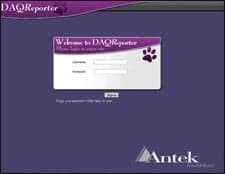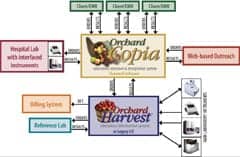 |
| The 22-year-old CompuNet lab services a 15-county area of southwest Ohio. VP of operations Paul Labbe estimates the laboratory is a $68 million operation, two-thirds of which is attributed to outreach. |
 |
| The DAQReporter Patient Portal is a secure, Web-based portal through which patients can view current and historical laboratory data and test information. |
 |
| Orchard Software’s Copia is an outreach and integration solution designed to work with the many varied EMRs of laboratory clients. |
Dwindling reimbursements—and revenues—have been a concern for many health care providers since before the economic downturn. Hospitals and clinical laboratories have long had to be flexible in creating new streams of revenue to make up for lost earnings. For the lab, outreach efforts have provided an obvious avenue for this new income.
“Years ago, only a handful of the nation’s hospitals, labs, and physician’s offices were operating true outreach programs. However, as the financial landscape continues to evolve and these clinical areas are expected to be profit-centered, hospitals, labs, and physician’s offices feel increased pressure to optimize their systems and focus on the bottom line while still providing the best possible patient care,” says Gilbert Hakim, CEO of SCC Soft Computer Inc, Clearwater, Fla.
To be successful, clinical laboratory outreach efforts need to offer the services needed in the market, communicate that availability, consistently deliver those services through easy-to-use electronic systems, properly bill for the services delivered, and ensure accounts payable are actually paid. The ability to manage and mine this information can also improve business efforts. Administrators can gather useful information, such as which send-out tests have enough volume to bring in-house or whether a potential contract will be profitable.
Any edge helps, since the market has grown more crowded. “It’s very competitive out there,” says Paul Labbe, vice president of operations for CompuNet Clinical Laboratories, based in Dayton, Ohio. The 22-year-old laboratory services a 15-county area of southwest Ohio. Labbe estimates the laboratory generates more than $60 million, two-thirds of which is attributed to outreach.
Uniquely owned through a joint venture between Dayton’s Miami Valley Hospital, Quest Diagnostics Inc (headquartered in Madison, NJ), and Valley Pathologists Inc, the organization operates a lab in Miami Valley Hospital, a centralized reference lab, and two satellite rapid response labs. CompuNet has been able to claim more than 65% of the outreach market in the greater Dayton area and smaller percentages in communities farther out, according to Labbe.
It is the smaller communities that now represent the laboratory’s largest opportunity for growth. However, these regions can be difficult to break into due to existing partnerships. In these instances, CompuNet will offer esoteric services, which may not already be available through the existing structure.
CompuNet was one of the first laboratories in the region to offer flow cytometry and molecular diagnostics. “We have the volume and resources to install the instrumentation, bring in the technical expertise, and market the services to a much larger volume outside the hospital,” Labbe says.
Resources include a 24-hour laboratory operation streamlined with Lean and Six Sigma techniques; 32 courier cars and 35 couriers who travel 65,000 miles per month picking specimens up at various sites as often as three times per day; electronic Web ordering and results delivery with connection options to satisfy all of its customers (“We have a lot of interface capabilities,” Labbe says); a sales team comprised of seven persons that address new sales, existing lab services, and technical specialization (“We always strive to keep our lost client ratio under 2 percent, and our retention rate has always been about 99 percent,” Labbe says); and an on-site billing department with 30 employees to manage this complex process.
 |
| Horizon Outreach for Lab helps laboratories to analyze and improve their outreach business. |
Software can help with many of these tasks, reducing error, improving turnaround, and increasing efficiency. “There are some industry-standard software features that are global among many LIS vendors and address outreach efforts for growing laboratory practices,” says Steward Macis, director of products and support services with Antek HealthWare LLC, Reisterstown, Md.
Macis cites features such as LIS scalability, Web-based orders and results functionality, HL7 interfaces that connect to EMR and practice-management systems, a rich interface reconciler, and practice segmentation to organize the patient data in a HIPAA-secure environment. “All of those features, as we stand here in the fourth quarter of 2008, should be fairly standard to LIS,” Macis says.
Yet, when a laboratory wants to expand its “outreach,” innovative tools can make its services more attractive than that of competitors. “It’s necessary to have the basic features, but novel features will set a laboratory apart and may help it to win an account. It’s a very competitive environment with low margins, so laboratories have to think outside the box for new and inventive services,” Macis says.
 |
| SCC’s Outreach Information Systems Suite features four applications: SoftWeb, a Web outreach results query and order entry system; SoftA/R, SCC’s accounts receivable information system; SoftCompliance, a medical necessity checking system; and SoftExpress, SCC’s outreach customer support application. |
Antek HealthWare’s New Communication Tools
To help laboratories offer new tools in keeping with today’s trends and technologies, Antek HealthWare will introduce two new features for 2009: the DAQReporter Patient Portal and a Mobile Messaging module. Both improve communication and are HIPAA compliant—the Patient Portal between physicians and patients and the Mobile Messaging between physicians and the lab.
Better communication can lead to better outcomes with greater efficiency in diagnosis and treatment. Health care organizations, physicians, and patients save some time and money as a result.
The DAQReporter Patient Portal is a secure, Web-based portal through which patients can view current and historical laboratory data. A dictionary of tests is also available; patients can access information about the test and references to help them understand the results.
“We feel like instant access to personal health care records is a growing trend due to computer-savvy Baby Boomers. The focus is on living longer and healthier, and this portal will empower patients to take increased control of their own lives,” Macis says.
Providing patients with instant access to their health care records is a progressive way for laboratories to enhance their services, according to Macis. Electronic results delivery not only improves the patient’s experience, but can also save paper, printing, and mailing costs for the laboratory. And, of course, if a client does not want the service, they can keep mailed results. “If a practice has several doctors and just a few don’t want the service, those few won’t get it. It’s very flexible,” Macis says.
Similarly, physicians who do not want to take advantage of Antek’s new Mobile Messaging module will not have to use the service. The new module makes use of the growing adoption of short messaging service or texting.
The LabDAQ module will give physicians the ability to be notified via text messaging based on rules that are set up by the LIS. The LIS can be configured to automatically notify physicians on critical values, result flags, delta flags, and many other parameters that are focused on critical care.
“The fact is that text messaging capabilities are now deployed in every make and model of mobile phone. The adoption rate of text messaging is continually growing in all demographic segments, which is a strong indicator that it’s a viable technology that should be utilized to improve health care,” Macis says.
He adds that giving physicians the ability to be immediately notified on critical diagnostic flags via text messaging can be another powerful differentiator to a potential laboratory client. Text messaging can also save the time of lab personnel who no longer need to make the phone call while providing the documentation of the message sent and received—”It’s one more tool cut down on manual processes,” Macis says.
CareEvolve’s Special(ization) Care
Digital outreach services are a tool that many clients have come to expect. In some instances, a client will use it as a negotiating tool. Brian T Jones, vice president of sales, marketing, and business development for CareEvolve, Elmwood Park, NJ, says he does get panicked calls from laboratories saying a large customer is about to walk unless the laboratory enhances its digital services. “It’s not a ‘nice-to-have’ thing anymore when it comes to outreach. It’s a ‘have-to-have,’ ” Jones says.
With urgent needs, laboratories want an order entry and results reporting system that will work immediately with its own LIS as well as the health care systems of its clients. This past year, CareEvolve introduced EMR eConnect, an EMR connectivity tool that permits interfaces to be set up very quickly—”2 to 3 weeks start to finish,” Jones estimates. The system currently boasts live EMR integration with more than 40 different vendors.
The LabEvolve software is used by CareEvolve’s parent company, Bio-Reference Laboratories Inc, headquartered in Elmwood Park, NJ. The organization’s more than 3,000 sites generate more than $300 million in revenues. Eighty percent of its orders are received electronically. The resulting shared knowledge provides CareEvolve with strong resources; nearly half of the employees have medical technologist backgrounds.
“We do a lot of customization based on our knowledge of the lab system and lab industry,” Jones says. CareEvolve offers a number of modules to match a laboratory’s specialties, including laboratory and pathology order entry/messaging, laboratory results, pathology results, radiology order entry/messaging, radiology results, a prison system module, a nursing home module, and the Healthvision portal. “We sell the system as one product and don’t charge extra for extra modules,” Jones says.
Reporting mechanisms are equally flexible and can mine data to provide information that can help with business decisions. “The system can run reports typically run by an LIS,” Jones says, adding, “For instance, how many CBCs a client has ordered in the past month.”
The company is currently developing a courier tracking system that will use “Fed Ex-type tracking tools,” according to Jones. Couriers will be tracked through a global positioning system (GPS) and can transmit data, including the quantity of specimen and the tests ordered, back to the lab. “The service will be fully integrated into the system, so when the courier scans the bag at the customer site, the laboratory will immediately know what is coming,” Jones says.
The digital solution helps to lower costs, particularly on printing consumables, and to retain clients. “Once the system is in place, it makes it difficult for a client to leave. Bio-Reference loses very few customers after they get hooked up electronically,” Jones says.
Collection with McKesson
Of course, it isn’t enough to bring customers in. Laboratories also have to see an order through to the collection of payment. “With about 79 percent of hospitals having an outreach program and about 75 percent of those still utilizing their hospital information system for outreach billing, that creates some significant challenges for outreach programs,” says Bob Weathers, specialty vice president of pathology and lab medicine for the Revenue Management Solutions group of McKesson Provider Technologies, Alpharetta, Ga. McKesson’s Revenue Management Solutions Group provides labs with the ability to outsource their billing and accounts receivable management.
Hospital billing departments tend to devote more resources to collecting large-ticket payments, such as reimbursement for MR exams, than to much smaller laboratory charges, such as any $25 test. “Industry research estimates that 40 percent of all laboratory claims filed with Medicare and Medicaid are denied for one reason or another, and only half are actually corrected and resubmitted by the provider,” Weathers says.
A billing solution that incorporates avenues for both appropriate billing and follow-up will help to generate more income. Horizon Lab Financials by McKesson, an alternative to total billing outsourcing, permits a laboratory to bring the billing and reporting system in-lab. A combined outsourcing and in-house billing approach can also provide the expertise to improve collections on an outsourcing basis.
Bringing financial information into the laboratory system enables the lab to track its revenue with greater accuracy—or perhaps simply to actually track it. “One survey showed that 46 percent of outreach programs do not even know what their net revenue is, which is a staggering number,” Weathers says. The ability to access this information improves the ability of the laboratory to make smart business decisions.
“To compete with national labs, effective data management is critical,” Weathers says. It can also help to ensure that a laboratory collects all of the money owed it in a compliant manner.
McKesson implementation consultants will work with Horizon Outreach for Lab clients before any software implementation to analyze and improve the clients’ outreach businesses. This new service, Key Success Factors Consulting, offers a comprehensive, no-cost, prospective return-on-investment analysis that uses 49 factors to predict outreach business costs, revenue, cash flows, contribution margin, payback duration, IRR, and NPV; and the ability to estimate items such as bad debt, the number of vehicles required, the number of couriers needed, the number of med techs needed, and the number of customer service reps needed.
“If you have a well-managed outreach business, you can probably earn between a 20- and 30-percent contribution margin, but the key is it needs to be run as a business and not a start-up operation,” says Jay Nakashima, senior product manager for Horizon Lab Financials with McKesson Provider Technologies.
 |
 |
 |
 |
| “Hospitals, labs, and physician’s offices feel increased pressure to optimize their systems and focus on the bottom line, while still providing the best possible patient care,” says SCC’s Gilbert Hakim, explaining the trend toward outreach. | “The ability to integrate into clients’ EMRs and other systems seamlessly and with as little effort as possible is a huge competitive benefit,” says Orchard Software’s Curt Johnson. | “It’s a very competitive environment with low margins, so laboratories have to think outside the box for new and inventive services,” advises Antek HealthWare’s Steward Macis. | “If you have a well-managed outreach business, you can probably earn between a 20- and 30-percent contribution margin, but the key is it needs to be run as a business and not a start-up operation,” says McKesson’s Jay Nakashima. |
Integrating with Orchard
The business must also be flexible and service oriented. For many, this translates into integratability. If a laboratory cannot offer an ordering and results-delivery system that is compatible with a potential client’s system, then that potential client no longer holds any potential. However, a laboratory that can offer digital services, even to clients without EMRs, can have an advantage.
“If you are lab with a lot of different clients, say 100, at some point in the future, you could have 100 different systems to integrate, all with different requirements and interface specifications, and you have to manage that,” says Curt Johnson, vice president of sales and marketing for Orchard Software, St Louis.
Orchard Software’s Copia is an outreach and integration solution designed to work with the many varied EMRs of laboratory clients. Customers without their own information or practice-management systems can connect via a Web portal where they can place orders and retrieve results. “It makes the lab more convenient and accessible to the providers,” Johnson says.
The system is configurable so that the process and interface can be tailored to each patient. The branding, order entry screen, and results and reporting pages can be configured differently for each physician.
“The ability to integrate into clients’ EMRs and other systems seamlessly and with as little effort as possible is a huge competitive benefit,” Johnson says. Seamless integration has been a common demand from clients in the past.
Electronic ordering also enables the lab to check for potential reimbursement issues during order entry and ensures accurate delivery. “You get clean orders into the lab, reducing errors, and you get results out in an efficient manner to the client in the way the client wants them sent,” Johnson says.
SCC’s Suite
SCC Soft Computer’s outreach solution is also designed to help catch errors. The Outreach Information Systems Suite features four applications: SoftWeb, a Web outreach results query and order entry system; SoftA/R, SCC’s accounts receivable information system; SoftCompliance, a medical necessity checking system; and SoftExpress, SCC’s outreach customer support application.
SoftExpress is a new program designed to integrate courier tracking, customer relations management, and business-to-business functionality. The system incorporates personal digital assistant and GPS technology to communicate information between field-based couriers and phlebotomists and the Web-based host application.
Day-to-day outreach business tools include tracking and dispatching couriers to client locations, documentation of all incoming and outgoing calls, management of customers’ supply inventory, and customized reports. “[The tools] enable our clients to be even more competitive in the constantly changing outreach environment,” Hakim says.
Looking ahead, SCC will continue to introduce improvements to SoftWeb. In 2009, upgrades will include recurring and standing orders functionality (which will save time by enabling users to enter a recurring order into the system once and have future orders generate automatically, according to Hakim) and generation of collection lists per location (useful for phlebotomists who travel to nursing homes, Hakim notes).

To stay current on outreach products, bookmark our website. |
The system is designed to enable hospitals, laboratories, and physician’s offices to optimize revenue and improve patient care. MeritCare Health System, headquartered in Fargo, ND, reported greater efficiency and a revenue boost following the implementation of SCC’s SoftA/R, SoftCompliance, SoftLab, and SoftMic.
Prior to implementation, the organization lost 26% of the claims submitted to Medicare/Medicaid for reimbursement and the associated $125,000 per month. “With SCC’s SoftA/R and SoftCompliance, MeritCare recouped over $60,000 per month almost immediately. Within a year and a half, the health care system was saving over $121,000 per month,” Hakim recounts. MeritCare, he adds, now has the people, processes, and technology working together to enjoy a savings of nearly $1.5 million per year.
With such great results, any organization is able to enhance its competitiveness. The right tools can enable a laboratory to expand its outreach efforts and its revenues.
Renee Diiulio is a contributing writer for CLP.


